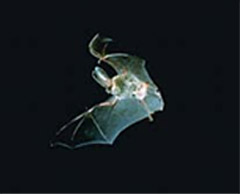
Townsend's Big-eared Bat
Bats
in the Salmon River Watershed
by
Tony Hacking
“If I were you, and had just been bitten by a bat I was trying to rescue from the river, I would carefully capture it and send it to the County Health Department for a rabies test”. This was my advice recently in response to a well-meaning youth, swimming at Blue Hole on the lower Salmon. Sure enough the strange acting bat was rabid and the lad is undergoing life saving treatment.
Bats have long fascinated me. What is it about these mysterious flying creatures of the night that arouse our emotions? Is there some inbred concern, born of our ancestral co-habitation with potentially harmful bats in the caves of the Pleistocene? Or has it more to do with urban legends surrounding vampire bats (a strictly New-World genera) or misconceptions about bats and rabies (rabies in bats is no more common than rabies in other mammal populations)? Perhaps it is because they are so bizarre. The only mammal that flies and echo-locates through air.
I think bat’s strangeness is part of what we fear and find compelling. But the more I learn about bats, the more I think of them as similar to us. Bats are generally social creatures; displaying some of the same complex social interactions that communal mammals like us exhibit. They display to one another during courtship. Bat mothers can pick out their own youngsters from a huge nursery full of ultrasonically screaming babies. I’ve even seen adult bats seemingly coming to the aid of brash young bats caught in a research net. With all the complex vocalizations bats need to make in order to echolocate, it wouldn’t be hard to imagine them communicating in a complex fashion as well.
Bats in the wild use caves, cracks, holes and loose bark as shelters, but it seems to me that just as us humans would prefer a snug house over the caves of our ancestors, bats often prefer the more civilized surroundings of a mine, bridge or building. This thought came to me as I was monitoring the use of some custom-made “bat houses” put up by my predecessor. Why would a bat leave the natural comforts of sloughing bark for something fabricated from plywood and paint? Indeed, why would a bat give up a cozy cave to live in your attic?
Bats in houses are one of the most common topics to come up in discussions about bats. In general, a few bats around the place are to be desired for the mosquitoes and other insect pests they eat. But if you are concerned about the weight of all that guano sagging the ceiling, or if you don’t like all those bats flying around inside your house at night, (no, they don’t try to get stuck in your hair), the thing to do is to find their entrances and hang a piece of orchard netting over the hole so bats can fly out but get stopped by the hanging flap of netting when they try to return. Its best to wait until after August to exclude bats if you suspect there is a nursery colony or juvenile bats in the house. You wouldn’t want them to die (and smell) inside your walls.
As with most things in our watershed, the bat fauna is diverse, with about ten species represented. These include (in order of netting occurrence) the ubiquitous Yuma Myotis, the similar Little Brown Myotis, the beautiful Silver Haired Myotis the California Myotis, the rare Townsend’s Western Big-eared Bat (from a known colony near the mouth of the Salmon River), the Big Brown Bat (implicated in the biting at Blue Hole), the Long-eared Myotis, the Small-footed Myotis, the bizarre Fringed Myotis, and the shimmering Hoary Bat.
So the next time you encounter one of these fascinating creatures, please don’t think of it as evil, but reflect on the wonder of our diverse and pristine natural environment here on the Salmon River.
Tony Hacking is a wildlife biologist for the U.S. Forest Service, Orleans District and president of the Junction School Board of Trustees